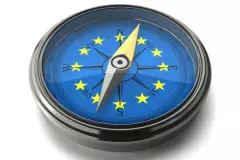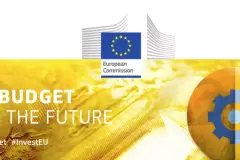An overview of the EU recovery plan
In spring 2020, no one could have foreseen the force with which the Corona pandemic would sweep across Europe. Nevertheless, the EU heads of state quickly agreed that joint measures had to be taken. And yet, the European continent has been hit hard, with several million cases and billions in economic losses. At the EU level, short-term agreements were rapidly reached on a number of important support schemes, including the European Commission's proposed SURE instrument to support short-time work schemes, the ESM's near-unconditional instrument to support pandemic crises, and the EIB's Pan-European Guarantee Fund.
However, in order to sustainably support those most in need, nurture investment and reform as well the European Commission launched the so-called EU Recovery Plan. With around 1,800 billion euros, this is the largest economic stimulus package ever financed from the EU budget. In this article you will learn how you can benefit from the plan and what exactly is behind it.
What's behind the recovery plan?
The European Recovery Plan is a package in two parts. The first part is the adjusted EU Multiannual Financial Framework (MFF) for the years 2021-2027. In early 2020 due to the necessities the MFF was further topped up and given new priorities. If you want to know more about the development of the financial framework, and why it was almost not agreed on in time, read here. The second part of the recovery plan is the Next Generation EU Fund (NextGenEU). This is a temporary recovery plan for the years 2021 - 2022 that aims to cushion the impact of the Corona pandemic on European society and economy by supporting reforms and investments. Nevertheless, it also focuses on overarching thematic priorities such as the Green Deal, digitalization and EU resilience.
The first part: Financial boosts for the Multiannual Financial Framework
The MFF is intended to establish budgetary discipline and ensure that EU spending remains predictable. This long-term perspective is particularly important for potential recipients of EU funds or authorities involved in funding projects. Because the budget was not prepared for the pandemic and its effects on the EU economy and life, EU leaders agreed in spring 2020 to jettison some parts of the previous negotiations. This allowed them to set new priorities and create a budget that could lead Europe out of the crisis. The new 2021-2027 budget, adopted on December 12, 2020, therefore also provides greater support for social development, recovery and resilience building for the future.
The second part: Next Generation EU
Next Generation EU is the new fund of the EU, the money of which is to be used exclusively to combat and mitigate direct corona-related damage. To finance this fund, the Commission is for the very first time borrowing up to €750 billion on the financial markets on behalf of the Union. However, the money raised in this way must then be repaid from future EU budgets starting after 2027, but no later than 2058.
The President of the Commission, Ursula von der Leyen, summarized the NextGenEU economic stimulus instrument with its 3 pillars as follows:
- it is focused on areas of greatest need and potential;
- it is short-term in nature, focusing on the key early years of the recovery up to 2022
- it will include a combination of grants and loans; and
- it will include the possibility of advancing some of the investment before the end of 2020, using proven financing models based on national guarantees.
NextGen Pillar 1: Supporting Member States to recover, repair and emerge stronger from the crisis
With a financial envelope of €672.5 billion (89,7%), the Recovery and Resilience Facility (RRF) is the centerpiece of this pillar and of the whole NextGenEU. The facility will support public investment and reform in Member States, helping them to address the economic and social impacts of the COVID-19 pandemic, as well as the challenges of the green and digital transformation.
Source: Eu Kommission - https://ec.europa.eu/info/business-economy-euro/recovery-coronavirus/recovery-and-resilience-facility_de. Abgerufen am 04.01.2021
The money is divided into €312.5 billion in grants and €360 billion in loans, with 37% of the money to be invested in green investments and reforms and 20% in digital investments and reforms. This is ensured through distribution by means of so-called build-up and resilience plans.
In a first step, the member states must now clearly present to the EU how they would spend the money by means of these plans in order to then receive funds via the European Semester. But to do so, the Recovery Plans must also clearly address challenges, such as corona-related issues that require significant investment to rebuild jobs and growth in the European Semester. The following seven investment areas were identified by the EU Commission and passed on to member states:
- clean technology and renewables
- energy efficient buildings
- sustainable transport and recharging stations
- broadband service deployment
- digitization of public administration
- data cloud capacity and sustainable processors
- education and training to support digital skills.
Particularly the grants for the member states must be spent until 2023., 70% of it until the end of 2022 and 30% until 2023. For the control of the measures and plans of this huge instrument, by the way, the EU Commission has set up its own task force. Obviously, lessons have been learned from the past.
NextGen pillar 2: Kick-starting the economy and helping private investment get moving again
The second pillar consists of investments for the React-EU reconstruction programme, the new Strategic Investment Facility. It is the second largest instrument of the NextGen Fund, and the only one in the "Revitalizing the Economy and Private Investment" pillar. Moreover, it was designed to support investment in key resilience sectors in Europe, such as the pharmaceutical and transport sectors. The investments will be supported by the NextGenEU with €47.5 billion and are particularly intended to build Europe's future resilience and strategic autonomy.
Originally, a separate instrument to support companies affected by insolvency was also planned. At the time, this was known as the Solvency Support Instrument. It would have helped to find the new capital needed by ailing but intrinsically viable companies and to cover them themselves in an emergency.
NextGen pillar 3: Learning the lessons of the crisis and addressing Europe's strategic challenges
The third pillar is probably the most contested, in terms of budget and distribution. This pillar holds additional money for other European programmes and funds such as Horizon Europe, the agricultural fund and the InvestEU financial programme. In the end, only five funds are supported, although for a long time other sectors such as the new, increased health programme and external aid were supposed to be supported. In the end, more money from the 7-year EU budget was made available for these programmes.
InvestEU stands out among these, so we will briefly discuss it separately. It is the newly established and now all-encompassing, general EU financial programme that will replace the many loose programmes and instruments that had formed in the EU over the years on finance and investment. It is supported by the NextGenEU with €5.6 billion, which represents two-thirds of its total budget of €8.2 billion. Originally, however, it was to receive nearly €30 billion and be located in Pillar 2. By many, the cuts were seen as a clear rebuff to the recovery of Europe as a whole, which fell victim to negotiations among national leaders. However, the budget should not hide its size, as InvestEU is made up of only a small portion of EU budget money. From the €8.2 billion, a portfolio of several hundred billion euros is assembled through investments from other sources. How exactly InvestEU works and which subsidies will be available in the future, especially for small and medium-sized enterprises, is explained in this article.
In a nutshell
The European Recovery Plan is the largest EU economic stimulus package ever financed from a single budget. It comprises the realigned multi-annual financial framework 2021-2027 with its nearly €1080 billion and the reconstruction instrument Next Generation EU with a volume of €750 billion. The money for this has been borrowed from the financial markets by the EU Commission on behalf of the member states.
The reconstruction plan is to be used to repair the immediate economic and social damage of the Corona pandemic, and to create a resilient Europe of the future. It is based on three pillars, the first being the largest and primarily supporting the Recovery and Resilience Facility. Pillars 2 and 3 focus on grants of individual programmes to help Europe out of the crisis. This will help achieve Europe's goals of being greener, more sustainable, more digital, and more resilient.








